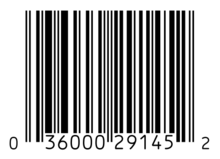Universal Product Code
The Universal Product Code ( UPC ) is a barcode used to identify products in retail stores . A number code is encoded , which the barcode scanner reads optically without contact .
It was introduced in the USA in 1973 . Norman Joseph Woodland and George J. Laurer (1925–2019) played a key role in its development . The first patent dates back to 1952. However, the idea has not yet been technically implemented.
The European Article Number (EAN) followed three years later . The EAN is compatible with the Universal Product Code, but encodes one more character. In the USA and Canada, the UPC is currently the only coding that is accepted by the entire market. If you put a leading zero in front of the UPC, the string of numbers can be used as a valid 13-digit EAN. Many international companies therefore only use the UPC code in the consumer goods sector.
The first six digits of the UPC A code (also called GTIN 12) can be used to clearly assign a product to a manufacturer or retailer. The owner of the number range can distribute digits 7 to 11 to his products. The 12th digit is a check digit that is calculated according to modulo 10 with a weighting of 3.
Companies can purchase UPC number ranges from GS1 for a fee.
See also
Individual evidence
- ^ Münstersche Zeitung : Father of the barcode died: N. Joseph Woodland did not get rich with his idea, but he still revolutionized trade , business and consumers, New York, dpa / AFP, December 15, 2012
- ↑ Inventor of the barcode died on ORF December 9, 2019, accessed on December 9, 2019
Web links
- EAN MediaWiki extension , a MediaWiki extension that visually displays UPC / EAN-13 / EAN-8 / Code39 / Codabar barcodes only by specifying the barcode number / symbols.
- UPC-Search.org free online database to research UPC codes
